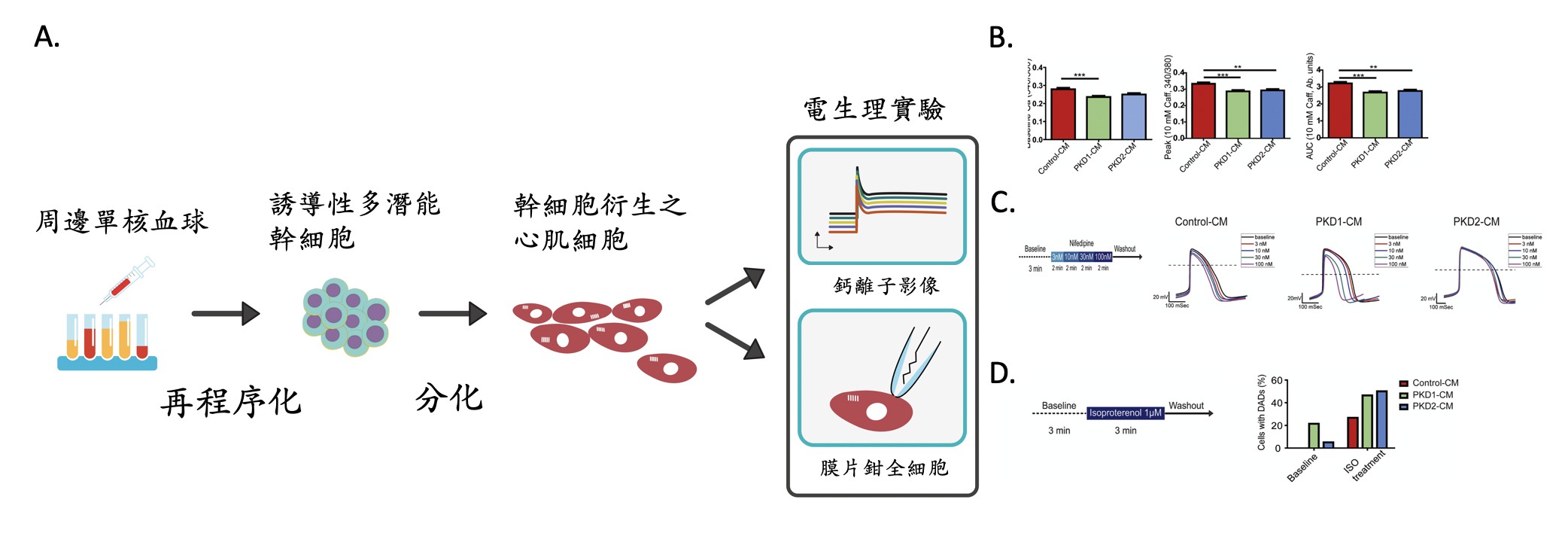
人類幹細胞研究顯示體顯性多囊腎基因突變導致心臟血管問題
臺灣是全世界腎衰竭發生率及盛行率最高的國家,體顯性多囊腎(俗稱泡泡腎),是腎衰竭第四大病因,是最常見導致腎衰竭的遺傳性腎臟病,盛行率約1:400-1:1000,佔台灣洗腎病患的2.3 %,有一半的機會會傳給下一代,心臟血管併發症是多囊腎患者最重要也是最常見的死因,目前仍無有效的治療。
「利用人類誘導性多潛能幹細胞(iPSC)研究」
人類疾病研究及治療突破不易,常受限於組織細胞取得不易及動物和人類的差異,人類iPSC是日本山中伸彌教授於西元2007年發表,2012得到諾貝爾生醫獎,因幹細胞科學的發展,本研究是將患者的血球細胞產製為iPSC,利用其多潛能的特性,將幹細胞分化為類心肌細胞來做研究。
「體顯性多囊腎基因突變導致心肌細胞電生理變化」
體顯性多囊腎病患之iPSC-CMs和由正常株iPSC所產製的心肌細胞(Control-CMs)相比較,病患的iPSC-CMs細胞內的肌漿網狀體的鈣離子含量較少。本實驗由PKD2病患的iPSC-CMs記錄到的自發性的動作電位,具有較慢的跳動速率及較長的動作電位持續時間。以L-型鈣離子阻斷劑做測試,PKD1病患的iPSC-CMs和Control-CMs具有相類似的、和劑量成正比的、縮短phase 2再極化時期的反應,且會導致細胞跳動的速率增加。PKD1病患的iPSC-CMs同時具有較不穩定的基準線,有較高比例的細胞發生延遲後去極化(DADs)。此外,PKD1及PKD2病患的iPSC-CMs相較於Control-CMs,發生更高比例的β腎上腺素受體刺激劑誘發的DADs。
綜合而言,運用電生理的實驗方法發現,體顯性多囊腎病患iPSC衍生的心肌細胞,自發性的動作電位、跳動速率、及對藥物的反應,與原病患臨床紀錄近似。體顯性多囊腎病患iPSC所衍生的心肌細胞有較高比例發生延遲後去極化,具有心律不整的傾向。依此結果推測,多囊腎的基因突變可能和多囊腎患者的心臟血管併發症相關。
「目前研究進展及未來方向」
本研究團隊在臨床上,已經開始進行多囊腎病患的世代研究,會收案多囊腎患者做基因診斷及更詳細的心臟及血管方面的評估,以釐清臨床關聯並可早期治療; 實驗室部分,研究團隊繼續以iPSC幹細胞研究,並運用 CRISPR-Cas9技術產製校正株,持續進行疾病機轉的研究及發展治療。
經費來源:科技部,中央研究院,高雄醫學大學附設醫院,高雄醫學大學,國家衛生研究院
圖形摘要

圖示:A.研究方法簡圖,將體顯性多囊腎病患的血球細胞,經過再程序化的過程產製為誘導性多潛能幹細胞(iPSC),再將iPSC分化衍生出類心肌細胞,以鈣離子影像及膜片鉗全細胞記錄做電生理的實驗及研究。B. 鈣離子影像實驗顯示病患的iPSC-CMs細胞內的肌漿網狀體的鈣離子含量較少。C. 病患iPSC-CM對鈣離子阻斷劑的反應不同。D.病患iPSC-CM較易被腎上腺素受體刺激劑誘發的發生延遲後去極化。
本校主要研究者之簡介:
本文第一作者李佳蓉助理教授接受中研院謝清河教授及高醫陳鴻鈞教授指導,於高醫中研院研讀並完成轉譯醫學博士學位學程,主要研究主題為:人類誘導性多潛能幹細胞、體顯性多囊腎、腎臟學。
研究聯繫Email:
李佳蓉
期刊出處:
EBioMedicine. 2019 Feb;40:675-684.
期刊線上參閱網址:
New finding revealed by iPSC derived cardiomyocytes suggest the direct link of ADPKD mutation genes to cardiovascular complication
Taiwan has the worldwide highest incidence and prevalence of end-stage renal disease. Autosomal Dominant Polycystic Kidney Disease (ADPKD), is the 4th leading cause of renal failure and is a hereditary kidney disease. Patients of ADPKD suffered from bilateral enlarged kidney with numerous cysts and progressive kidney failure. Cardiovascular complication represents the major cause of ADPKD patients’ mortality. Till now, we still have no effective therapy for ADPKD and its complications.
Research group by Dr. Jia-Jung Lee, Professor Chen of Kaohsiung Medical University and Professor Hsieh of Academia Sinica applied the advanced technology of human induced pluripotent stem cells (iPSC). They firstly generated ADPKD patient-derived iPSC as an important seed for exploring and dissecting this complicated, multiple-organ involved disease.
In the article published in EBioMedicine February 2019, the research group firstly identified the proarrhythmia phenomenon of ADPKD. The calcium image study showed altered calcium handling of the ADPKD iPSC derived cardiomyocytes. Further electrophysiological experiments with whole cell patch clamping revealed remarkable similarity of spontaneous beating pattern and the drug responsiveness of the ADPKD iPSC derived cardiomyocytes with their donors. More importantly, both ADPKD lines had proarrhythmia characteristics elicited by beta-adrenergic agonists. Taken together, the results from the ADPKD patient-specific iPSC suggested possible direct links of the mutation genes with the cardiovascular complication of ADPKD patients.
Our result pave the way to comprehensively evaluate the cardiac manifestation of ADPKD population. The research team are continuing in studying the mechanism of the mutation genes leading to the cardiac manifestation. The cell renewal and pluripotency characteristics of iPSC are promising in establishing human cell-based, in vitro disease models, drug screening platforms, and developing effective novel therapies in the anticipated future.
Fund: Ministry of Science and Technology, National Health Research Institutes, Academia Sinica Program for Technology Supporting Platform Axis Scheme, Thematic Research Program and Summit Research Program, Kaohsiung Medical University Hospital, Kaohsiung Medical University, Taiwan.
Graphical Abstract

Figure: A. Schematic diagram modeling ADPKD cardiac electrical characterization with patient induced pluripotent stem cell derived cardiomyocytes (iPSC-CMs). B. Lower Calcium content in the patient iPSC-CMs by the calcium image study. C. Blunted response to L-type calcium channel blocker of the PKD2 patient iPSC-CMs. D. More baseline and β-adrenergic agonist-induced delay after depolarization of the patient iPSC-CM by the whole cell patch clamp study.
Main researcher Intro.
Researcher Jia-Jung Lee, M.D., Ph.D., Kaohsiung Medical University Hospital and Kaohsiung Medical University
Author Email
Paper cited from:
EBioMedicine. 2019 Feb;40:675-684.
Paper online website
穩定物價,打擊不法,請撥【舉報商品囤積】免費專線:0800-007-007!法務部調查局關心您。
穩定基本民生物價,為政府重要政策目標。行政院已成立跨部會之「穩定物價小組」,加強從國內上、中、下游之生產到銷售的整體流程掌握與監控,並適時採取各項穩定物價措施,確保穩定民生物價,以保障消費者權益。
防範囤積,穩定物價,打擊非法,你我一起努力,共創美好未來。
【防疫新生活 暑期新日常】
親愛的教職員工生,大家暑期愉快!
連日大雨,祈願各位府上一切安好!
時光飛逝,轉眼暑假已經過了一半。今年,由於COVID-19疫情的影響,我們的日常生活受到了些許約束而改變,感謝所有校院同仁配合政府措施並防疫有成,終於在暑假前得以讓臺灣疫情露出曙光 。相較於世界各國,臺灣的民眾幸運地有此喘息的機會,可以出外走走,稍解疫病威脅所帶來的緊繃與壓力。
然而,這並不代表危機已全然解除,國際疫情顯示許多國家仍繼續延燒中,換言之,我們對於疫情不應輕忽而使之有機可趁。所以,即使各項防疫措施逐漸放寬,公共衛生觀念與習慣的維持不只是醫護同仁與政府機關的責任,更需要大家配合落實,才能保有目前為國際間所稱羨的後疫情時代生活。
因此,校長要提醒大家於暑期中,在社交場合無法保持適當距離、需要前往人潮擁擠的場所,例如:大眾運輸場站、醫療院所、宗教集會、大型活動;或者與人共處於密閉空間,例如:電梯、車廂、賣場、教育學習場域(補習班)、休閒娛樂場所(電影院、KTV),請佩戴口罩保護自己與他人,並養成勤洗手、注意咳嗽禮節等以降低感染風險。若有發燒及身體不適,請務必戴上外科口罩就醫。
高醫校園內師長與同仁們都隨時注意疫情的各項訊息與變化,持續進行各個公共區域(如:餐廳與教室)的整修與清潔,亦配合教育部和疾病管制署的規定進行境外生的就學聯繫與安排,以維護校園安全、迎接新學期的到來。在此期間,呼籲大家避免出國,若有出國之必要,請提出申請並依程序請假。還有,進出校園時,應配合相關管制措施,同時請各位隨時留意政府單位及學校防疫專區網站的最新公告。
再次感謝所有校院同仁與教職員生的努力與合作!疾病的預防與健康的維護需要我們與政府「逗陣做夥來」,防疫新生活就從自身做起,讓我們好好發揮高醫人的醫學素養與影響力,推及家人、鄰居與朋友,共同守護臺灣大家園。
謹祝暑假愉快!
高雄醫學大學校長 鐘育志 敬啟
109年8月5日